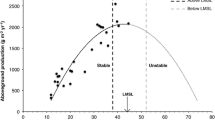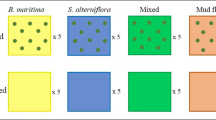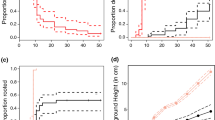Abstract
Most marine habitats are generated by the presence of habitat-modifying species. However, little is know about many aspects of this process, such as how individual- and population-level traits of habitat modifiers affect their ability to reduce environmental stress and thus facilitate other species. An important habitat modifier in New England is the intertidal grass Spartina alterniflora which facilitates the establishment and persistence of cobble beach plant communities by reducing wave-related disturbance. The objectives of this study were to (1) quantify the modification of cobble beach habitats by S. alterniflora, (2) determine how this process is related to S. alterniflora bed traits, and (3) determine why small patches of S. alterniflora generally remain unoccupied by cobble beach plants. Our results demonstrate that S. alterniflora substantially reduces flow-related physical disturbance on cobble beaches. Behind S. alterniflora, mean flow velocity was reduced by 40–60% and substrate stability was dramatically increased compared to portions of the shoreline not bordered by this species. These comparative results were supported by a S. alterniflora shoot removal experiment, which resulted in a 33% increase in average flow velocity and an 85% increase in substrate instability relative to control areas. There was a strong inverse logarithmic relationship between bed length and both average flow velocity and substrate instability behind S. alterniflora. Most S. alterniflora beds were small and bed length was significantly related to the presence of one or more cobble beach plant species. Only 13% of beds <25 m and 40% of beds 30–40 m in length were occupied, in contrast to an occupancy rate of 87% for beds >40 m long. Seeds of two annual cobble beach species (Suaeda linearis and Salicornia europaea) were added to plots behind large (>100 m in length) and small S. alterniflora (<25 m) beds with and without a substrate stabilization manipulation. Seedlings of both species only emerged and established behind small beds when the substrate was stabilized. These results indicate that smaller S. alterniflora patches are usually unoccupied because they do not stabilize the substrate to a degree that meets the establishment requirements of seedlings. Thus, both habitat modification and facilitation by S. alterniflora are patch-size dependent. The conditionality of this facilitation appears to generate a pattern of patchy yet predictable population and community distribution at a landscape spatial scale.
Similar content being viewed by others
Author information
Authors and Affiliations
Additional information
Received: 2 November 1998 / Accepted: 15 July 1999
Rights and permissions
About this article
Cite this article
Bruno, J., Kennedy, C. Patch-size dependent habitat modification and facilitation on New England cobble beaches by Spartina alterniflora . Oecologia 122, 98–108 (2000). https://doi.org/10.1007/PL00008841
Issue Date:
DOI: https://doi.org/10.1007/PL00008841




